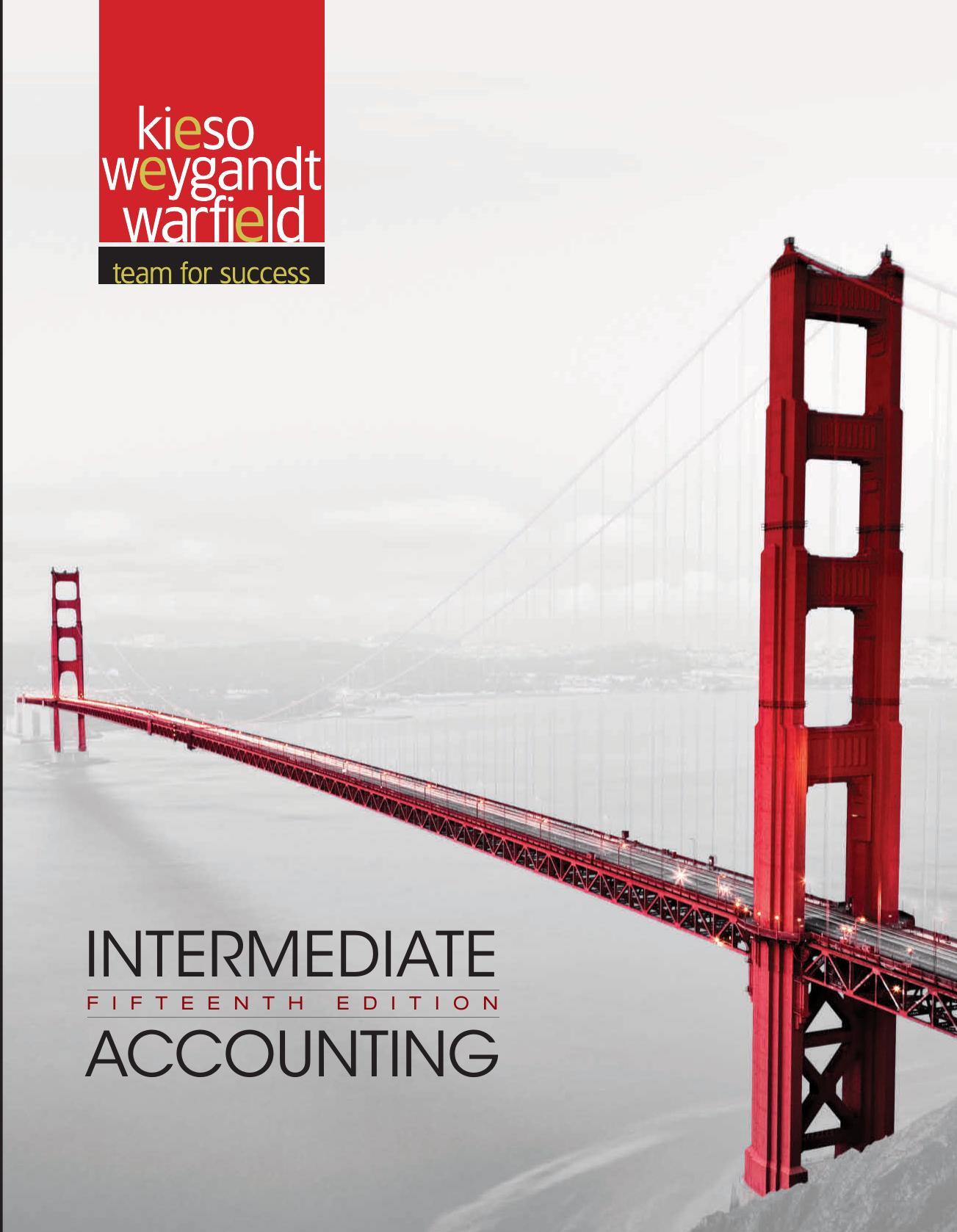
More products digital (pdf, epub, mobi) instant download maybe you interests ...

Financial & Managerial Accounting Jerry J. Weygandt & Paul D. Kimmel & Donald E. Kieso
https://ebookgrade.com/product/financial-managerial-accountingjerry-j-weygandt-paul-d-kimmel-donald-e-kieso/
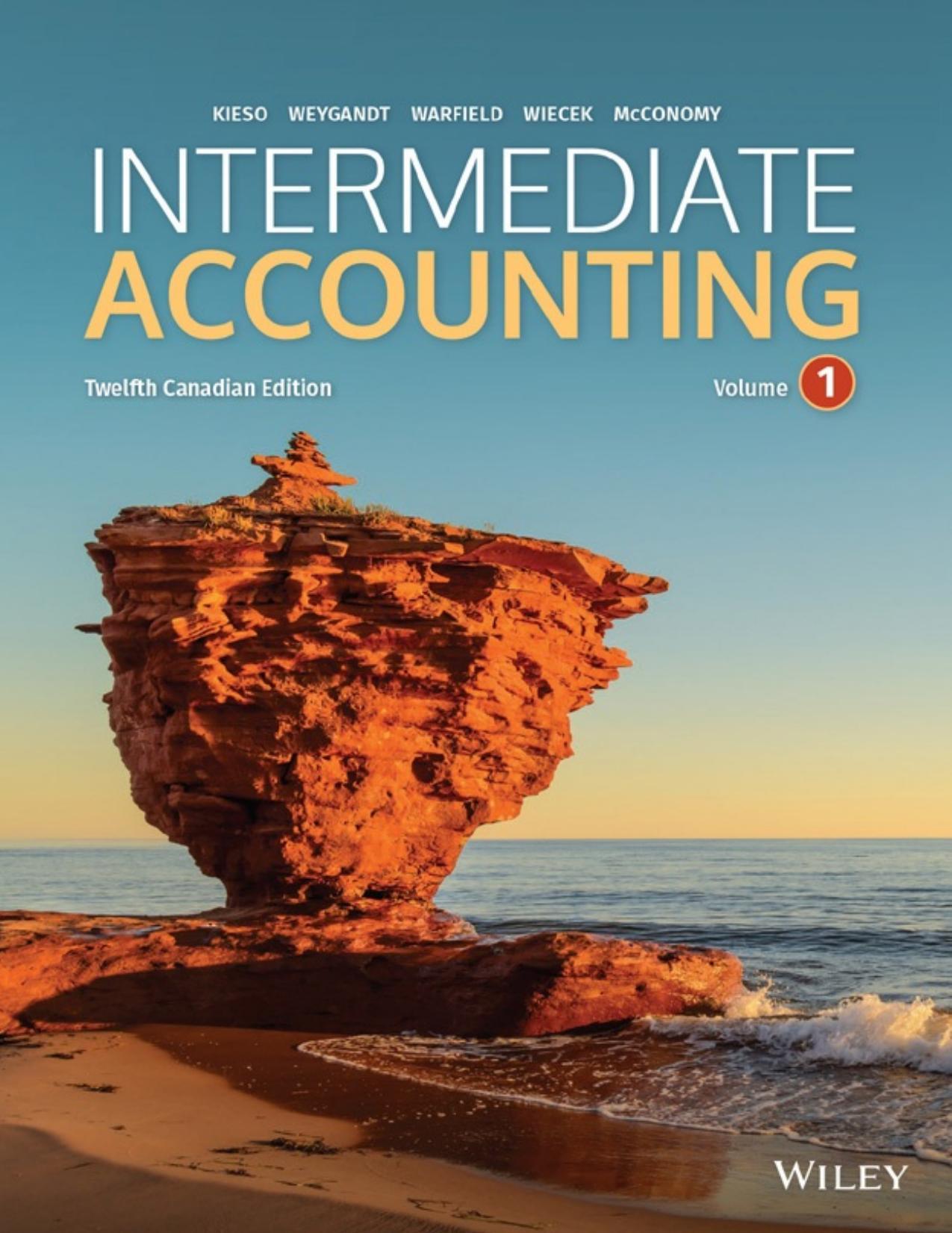
Intermediate Accounting Volume 1 Canadian Edition 12th EditiJ. J. WEYGANDT & T. D. Warfield & I. M. Wiecek & B. J. McConomy
https://ebookgrade.com/product/intermediate-accountingvolume-1-canadian-edition-12th-editij-j-weygandt-t-d-warfield-im-wiecek-b-j-mcconomy/

Accounting Principles 13TH by Jerry J. Weygandt
https://ebookgrade.com/product/accounting-principles-13th-byjerry-j-weygandt/
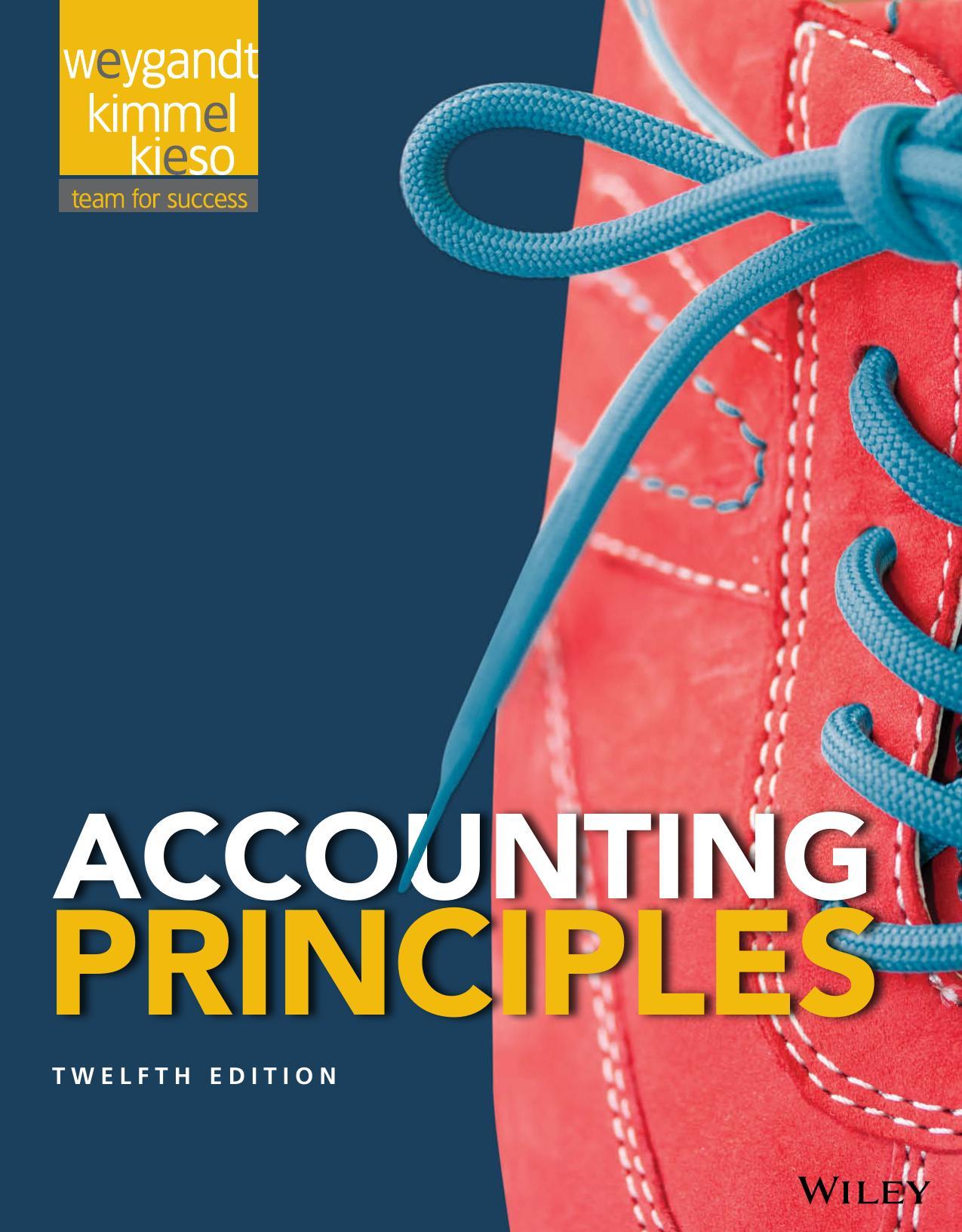
Accounting Principles 12th Edition by Jerry J. Weygandt
https://ebookgrade.com/product/accounting-principles-12thedition-by-jerry-j-weygandt/

(Solution Manual) Intermediate Accounting 17th Edition by Kieso D. E. Weygandt
https://ebookgrade.com/product/solution-manual-intermediateaccounting-17th-edition-by-kieso-d-e-weygandt/

(Test Bank) Intermediate Accounting 17th Edition by Kieso D. E. Weygandt
https://ebookgrade.com/product/test-bank-intermediateaccounting-17th-edition-by-kieso-d-e-weygandt/

Managerial Accounting Tools for Business Decision Making 6th by Jerry J. Weygandt Jerry J. Weygandt
https://ebookgrade.com/product/managerial-accounting-tools-forbusiness-decision-making-6th-by-jerry-j-weygandt-jerry-jweygandt/
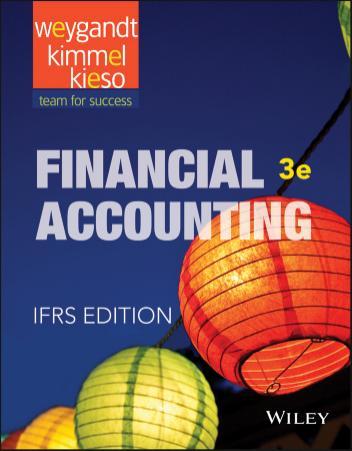
Financial Accounting IFRS 3rd Edition by Jerry J. Weygandt
https://ebookgrade.com/product/financial-accounting-ifrs-3rdedition-by-jerry-j-weygandt/
Another random document with no related content on Scribd:
birds’ nests, forgetting her motherhood, a proceeding which, being contrary to nature’s use, seems unnatural. It reads like a tale from the ‘Thousand and One Nights,’ in which we sometimes encounter human beings, good, or bad, or merely fantastic, who wander about the world disguised as birds. Only when we see and handle the cuckoo’s egg placed in the hedge-sparrow’s, or pipit’s, or wagtail’s nest, when we see the large hawk-like young cuckoo being fed and tenderly cared for by its diminutive foster-parent, do we realise the extraordinary nature of such an instinct. In spite of this ‘naughtiness’ of the cuckoo, to speak of it in human terms, it is to all a favourite, ‘the darling of the year,’ and from the days when the oldest known English lyric was written—
Summer is icumen in, Loud sing cuckoo,
to the present time the poets have found inspiration in his fluting call; and musicians, too, owing to that unique quality of his voice which makes it imitable and harmonious with human music, vocal and instrumental.
The cuckoo does not usually arrive in this country before the middle of April, but he is sometimes two, and even three weeks earlier. The males arrive first, and it is they that utter the well-known double call that gives the bird its name. The cry of the female, a curious prolonged bubbling sound, is heard less frequently.
One of the strangest facts in the strange history of this bird is that its egg is not laid in the nest in which it is found, but is carried by the cuckoo in her bill and placed there. It is very small for so large a bird, although much larger, in most cases, than the eggs it is placed with, as its favourite nests in this country are all of small birds—the hedge-sparrow, reed-warbler, pied wagtail, and meadowpipit. The eggs are very variable, being dull greenish or dull reddish grey, with spots and mottlings of a deeper shade. In some instances the cuckoo’s egg resembles in colour the eggs it is placed with, and it is thought by some naturalists that the female cuckoo invariably
deposits her eggs in the nests of one species. As a rule, only one egg is laid in a nest, and a few days after the eggs are hatched the young cuckoo gets rid of his foster-brothers by getting them on to his back, which is broad and hollow, and throwing them over the side of the nest. If any unhatched eggs remain in the nest, he gets rid of them in the same way.
The food of the cuckoo is exclusively insectivorous, and consists in large part of hairy caterpillars, which most birds refuse to touch. The indigestible portions of the food he swallows are cast up in small pellets.
By August the old birds take their departure; the young migrate one to two months later.
No fewer than three exotic cuckoos have been placed on the list of British birds. Two of these are American species: the yellow-billed cuckoo (Coccyzus americanus) and the black-billed cuckoo (C. erythrophthalmus). The third is the great spotted cuckoo (Coccystes glandarius), an African species, which visits Spain in summer, and, like our bird, is parasitical, but has the habit of depositing its eggs in the nests of various species of the crow family.
Barn-Owl.
Strix flammea.
Beak yellowish white; upper parts light tawny yellow minutely variegated with brown, grey, and white; face and lower plumage white, the feathers of the margin tipped with brown. Length, fourteen inches.
The barn-owl is one of the very few species that have almost a world-wide range. It is resident throughout the British Islands, and inhabits the greater part of Europe; it extends to Africa, including Madagascar; to India and America, and to the Malaysian, Australian, and Polynesian regions; and is found in islands so widely separated and far removed from the mainland as the Azores, Madeira, the Canaries, and Cape de Verde. The short-eared owl has a distribution just as wide, or even wider; but that bird, wherever found, is of a wandering habit, making his home and breeding-place wherever food is abundant, and staying not where it fails him. His action resembles, only on a vaster scale, that of the nomads of the human race, who break up their camp and move away from the district that no longer affords pasture to their cattle. Thus, in the case of this species, the vagrant habit may be held to account for so extensive a range. But the barn-owl’s universality cannot be accounted for in the same way, since he is, in most countries, a stay-at-home bird, and spends his whole life, from year’s end to year’s end, in the same spot. We can only conjecture that at some former and very remote period in the history of his species he, too, had a vagrant disposition; or else that he is a very ancient bird on the earth, and has had unlimited time to get so widely dispersed; also, that the barn-owl is one of those rare types that can exist unaltered in a great variety of conditions. One of our domestic birds, the goose, affords an instance of the unchangeableness of some types in all regions of the globe; but the goose has been carried everywhere by adventurous white men, while the barn-owl, by means unknown to us, has distributed himself over the earth.
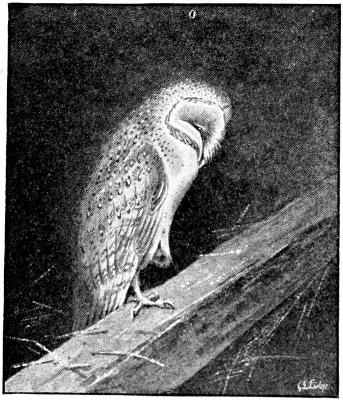
FIG. 66.—BARN-OWL. ⅐ natural size.
Another general remark about this most strange and fascinating fowl may be made in this place. The barn-owl, being so widely distributed, and in many countries the most common species, and being, furthermore, the only member of its order that attaches itself by preference to human habitations, and is a dweller in towns as well as in rural districts, is probably the chief inspirer and object of the innumerable ancient owl superstitions which still flourish in all countries among the ignorant. His blood-curdling voice, his whiteness, and extraordinary figure, and, when viewed by day on his perch in some dim interior, his luminous eyes and great round face, and wonderful intimidating gestures and motions, must powerfully affect the primitive mind, for in that low intellectual state whatever is strange is regarded as supernatural.
Before sitting down to write this little history I went out into the woods, and was so fortunate as to hear three owls calling with unearthly shrieks to one another from some large fir-trees under
which I was standing, and, listening to them, it struck me as only natural that in so many regions of the earth this bird should have been, and should still be, regarded as an evil being, a prophet of disaster and death.
The barn-owl takes up his abode by preference in a building of some kind—an old ruin, a loft in a barn or an outhouse; but above most sites he prefers an ivyclad church-tower, on which account he has been called the church-owl. He also inhabits caves and holes in cliffs, and hollow trees in woods. He spends the daylight hours, standing upright and motionless, dozing on his perch; and, where he is persecuted, he does not stir abroad until dark. When he is not molested he leaves his hiding-place before sunset, and is so little suspicious of man as to appear like a domestic bird in his presence. He preys on mice, rats, moles, insects, and even fish, which he has been observed to take in his claws from lakes and ponds. The indigestible portions of the small animals he swallows—the fur, feathers, bones, wing-cases, and scales—are disgorged in compact round pellets about the size of a cob-nut; and from an examination of a vast number of such pellets, it would appear that about ninetenths of the food of this owl consists of mice.
This fact is now so generally known that the owl, from being one of the most persecuted of birds, is becoming a general favourite; and farmers who formerly shot it, and nailed it, with outspread wings, to their barn-doors, in order that all might see and admire their zeal in ridding the earth of so misshapen a pest, are now only anxious to have the ‘feathered cats’ living in their barns again.
The owl makes no nest, and lays from two to six eggs, which are white and nearly round. It has the curious habit of laying two or three eggs, and, long after incubation has begun, laying others, and then others again, so that young of different ages and eggs not yet near hatching may be found in the nest together. The young make a curious snoring noise, which is their hunger cry; and it has been said that this cry is also occasionally uttered by the old bird on the wing.
Long-eared Owl.
Asio otus.
Beak blackish; eyes orange-yellow; upper parts buff, finely mottled with brown and grey, and streaked with dark brown, especially on the ear-tufts; facial disk buff, with a greyish black margin and outer rim; under parts warm buff and grey, with blackish streaks and minute transverse bars. Length, fifteen inches.
The long-eared owl may be described as a bird of beautiful plumage. The hues of the upper parts—various shades of yellow, buff, and brown, harmoniously disposed—and something, too, in the indeterminate pattern, remind us of the colouring of some of the very handsome cats. This cat-like colouring, long tufts of ear-like feathers, and large, round, fiery, yellow eyes, give the bird a singular and uncanny appearance. As a vocalist he is less interesting than the two other most common British species—the white owl, with its sepulchral shriek, and the tawny owl, with its mellow hoot—that mysterious sound of the deep woods at eventide. The commonest note of the present species is a mewing cry, heard when the birds begin to stir from their hiding-places before going out to forage. It also emits at times a short, barking cry.
The long-eared owl appears to be more gregarious than other species, except, perhaps, the short-eared owl. Mr. Abel Chapman writes: ‘A peculiarity of the habits of these owls after the breedingseason deserves a remark. As soon as the young were fledged the whole of the owls associated together, perhaps three or four broods, old and young, in a single family, and chose a thick black Scotch fir for their abode. Here they all passed the day. To this particular tree the whole of the owl-life of these woods resorted regularly at dawn, and in it slept away the hours of daylight, hidden amongst the deep evergreen recesses. At the particular tree of their choice (it varied in
different years) the owls could invariably be interviewed during the summer and autumn, though to a casual eye it was difficult, amidst the deep shadows of the foliage, to distinguish their slim forms, pressed closely against the brown branches of the pine. Towards dusk their awakening was notified by the querulous cat-like cry; ten minutes later their silent forms appeared outside the wood, and, after a few rounds of preliminary gyrations, it was dark enough to commence operations in earnest.’
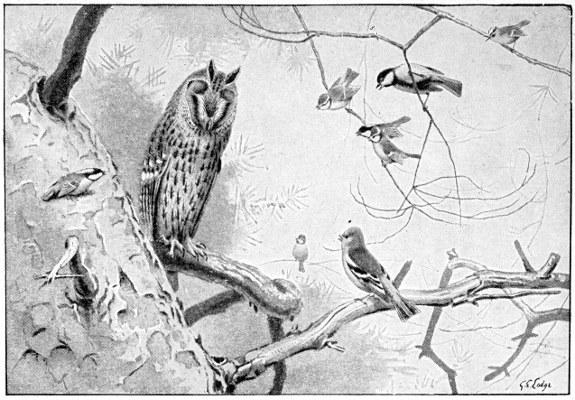
Field-mice and rats are its principal food; it also preys a good deal on insects, and kills more small birds than does the white owl. It is an early breeder, laying its eggs in the deserted nest of a crow, magpie, rook, or heron, or in a squirrel’s drey, or even making use of the slight platform-nest of the wood-pigeon. The eggs are four to six in number, nearly round in shape, and have smooth white shells.
Short-eared Owl.
Asio brachyotus.
Face whitish; beak black; iris yellow; tufts on the head small, composed of black feathers; eyes encircled by brownish black; upper parts dusky brown edged with yellow; under parts dull yellow streaked with brown. Length, fifteen inches.
In its habits the short-eared owl offers a strong contrast to the species last described. It is a bird of the moors and fens, laying its eggs on the ground, and never, or very seldom, perches on trees. In appearance it is less owl-like and uncanny-looking than the longeared owl, the colouring and markings being less rich, the head smaller, and the ear-tufts so small that at a distance of twenty-five yards they are scarcely visible. It is migratory in its habits, and as it arrives on the east coast at the same time as the woodcock, it is often called the woodcock-owl.
As a winter visitant it is found in most places in the British Islands, but it breeds with us only in Scotland and a few localities in the north of England. As I have said in the history of the barn-owl, the present species ranges over a large portion of the globe, and on the continent of America it is found from Greenland to the Straits of Magellan. It is not so nocturnal in its habits as the majority of owls, and may often be seen, an hour or two before sunset, beating over the rough ground like a hen harrier in search of prey. It feeds on small rodents of all kinds, and on birds. The eggs are three to five in number, and in some instances as many as seven or eight are laid, and are placed in a slight clearing among the herbage on marshy ground, or under the heather on a moor.
There is some variety in the language of this species: it hisses and makes a sharp clicking sound when angry, and has a loud, startling cry, a note repeated three or four times, like a ghostly
laugh; and it also hoots, this performance sounding like the baying of a dog in the distance.
An interesting and curious fact in the history of this owl is that it is known to appear, often in considerable numbers, in any district where, owing to a great increase of field-mice or other small rodents, its favourite food is for the time abundant. This phenomenon has been observed in various parts of the world, in this country on several occasions; and during the late great plague of short-tailed voles in the south of Scotland (1891–92), large numbers of short-eared owls appeared, and remained to breed in the district. As long as the plague lasted they remained in the country, and were most prolific. When the voles disappeared the owls departed.
Tawny Owl. Syrnium
aluco.
Beak greyish yellow; iris bluish dusky; upper parts reddish brown, variously marked and spotted with dark brown, black, and grey; large white spots on the scapulars and wing-coverts; primaries and tail-feathers barred alternately with dark and reddish brown; under parts reddish white, with transverse brown bars and longitudinal dusky streaks; legs feathered to the claws. Length, sixteen inches.
The tawny owl, named also brown owl and wood-owl, is by a little the largest of the four British species. In his colouring, as well as his woodland habits, he comes nearest to the long-eared owl, but he has no ear-tufts like that bird to add to his strangeness, nor is he in appearance so ghostly and grotesque as the white owl. This species alone of the British owls is unknown in Ireland. In England, Wales, and the south of Scotland it is to be met with in all wellwooded districts, and in some localities it is said to be the most common owl. But, unhappily, in many places where it was formerly
common it has been extirpated by gamekeepers. Owls are not very social birds, and the tawny owl is the most unsocial of all. He inhabits the deep wood, where he lives solitary or with his mate, and he is said to be very jealous of the intrusion of another individual of his species into his hunting-grounds. His chief distinction is his powerful, clear voice: heard in the profound silence of the woods at eventide the sound is wonderfully impressive, and affects us with a sense of mystery. This may be due to imagination, or to some primitive faculty in us, since the feeling is strong only when we are alone. If we are in a merry company, then the wood-owl’s too-whit, too-who, may even seem to us ‘a merry note,’ as Shakespeare described it.
The tawny owl sometimes breeds, like the barn-owl, in ruins, outhouses, disused chimneys, and such places; but the usual site is a hollow tree, all the more liked if it is overgrown with ivy. Sometimes he takes possession of a deserted nest of a magpie or crow to breed in. The three or four eggs laid are white, and nearly round in shape.
The tawny owl is strictly nocturnal in habits, and preys on mice, rats, moles, young rabbits, squirrels, and birds; and he also, like most owls, occasionally takes fish.
Besides the species described, no fewer than seven others have been included in books on British birds, and if these seven were not rare accidental visitors to our island we should indeed be rich in owls. It will be sufficient to give their names:—
Snowy owl (Nyctea scandiaca).
European hawk-owl (Surnia ulula).
American hawk-owl (Surnia funeria).
Tengmalm’s owl (Nyctala tengmalmi).
Scops owl (Scopsgiu).
Eagle owl (Bubo ignavus).
Little owl (Athene noctua).
It is possible that the last species may one day come to be ranked as a British bird, like the pheasant and red-legged partridge, as several attempts have been made to introduce it into this country, first by Waterton, in 1843; and, in recent years, by Mr. W. H. St. Quintin in Yorkshire, and Mr. Meade-Waldo in Hampshire.
Hen Harrier. Circus cyaneus.
Upper parts of adult male bluish grey; lower parts white; beak black; irides reddish brown; legs and feet yellow; claws black. Female: upper parts reddish brown; under parts pale reddish yellow, with deep orange-brown, longitudinal streaks and spots. Length: male, eighteen inches; female, twenty inches.
This very handsome and graceful hawk was fairly common within recent times in the British Islands. But the incessant persecution of all birds of prey by game-preservers is having its effect. It is plain to see that as British species they are being extirpated; and the first to vanish are the harriers, owing to their fatal habit of breeding in the open country on the ground. For while most birds have a close time allowed them, the hawks are sought out and destroyed, old and young, during the breeding season. Thus the marsh-harrier, which should have come first in this place, is now extinct in this country, and cannot be introduced into a work on British birds which does not include the great auk, the bustard, the spoonbill, and many other species which have been exterminated in England. The hen harrier is at the present time very nearly in the same case; it is only included here because a few pairs probably still breed on the wildest and most extensive moors in Wales, the north of England, and the Highlands of Scotland.
The nest is a slight hollow in the ground, scantily lined with a little dry grass; and the eggs are four or five, and rarely six, in number. These are pale bluish white in colour, and in some cases have pale brown markings.
The male hen harrier, seen on the wing when quartering the ground in quest of prey, keeping but a few feet above the surface, is certainly one of our handsomest hawks. Its flight, although not wavering, is as buoyant as that of the common tern, and the pale colouring—soft blue-grey above and white beneath—seems in harmony with its slender figure and airy, graceful motions. On account of its blue colour it has been called the dove-hawk. It preys on small birds, mammals, and reptiles, dropping suddenly upon them in the manner of the kestrel, but from a less height. The origin of its name of hen harrier is not known. Yarrell conjectured that it was on account of its predilection for the produce of the farmyard; which seems unlikely, as the harriers are usually hunters of very small deer. A more probable explanation is that the male bird was formerly supposed to be the female of the ringtail-harrier; but we know now that the hen harrier is the cock bird, and the ringtail the hen.
Montagu’s
Harrier. Circus cineraceus.
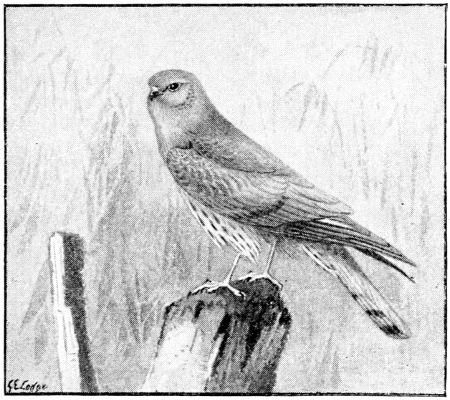
FIG. 67.—MONTAGU’S HARRIER. ⅑ natural size.
Upper parts bluish grey; primaries black; secondaries with three transverse dark bars; lateral tail-feathers white barred with reddish orange; under parts white variously streaked with reddish orange. Female: upper parts brown of various tints; under parts pale reddish yellow, with longitudinal bright red streaks. Beak black; legs and feet yellow. Length, eighteen inches.
This hawk was named by Yarrell after the well-known ornithologist, Colonel Montagu, who was the first to distinguish between this species and the hen harrier, which it so closely resembles. Seen on the wing at a distance of two to three hundred yards, the sharpest-sighted ornithologist would probably be unable to say whether the bird was a hen harrier or a Montagu’s harrier. The present species is slimmer bodied; but, owing to the greater
comparative length of its wings, it appears, when flying, as large as the hen harrier. It is a spring and summer visitor to this country, and in its flight, and preying and breeding habits, closely resembles the species last described. Small birds, mammals, reptiles, and insects form its prey. It breeds, or formerly bred, in suitable localities in most English counties from the south coast northwards to Norfolk, making its slight nest on the ground, among the furze-bushes or heather. The eggs resemble those of the hen harrier in colouring, but are smaller in size.
Buzzard.
Buteo vulgaris.
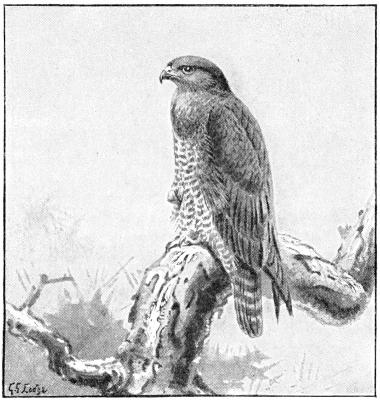
Upper parts, neck, and head dark brown mottled with brown of a darker shade; tail marked with twelve transverse bands; beak lead-
coloured; cere, irides, and feet yellow. Length: male, twenty inches; female, twenty-two inches.
It is impossible for anyone who loves wild bird life to write about the buzzard without a feeling of profound melancholy. For this hawk, too, like the harriers, although once common, and still called in books the common buzzard, is a vanishing species. Howard Saunders writes: ‘Fifty years ago it used to breed in Norfolk and in other counties abounding in partridges and ground game, without being considered incompatible with their existence; but with the increase of pheasant-worship the doom of the buzzard was sealed, for, the larger the “hawk,” the worse it must necessarily be!’
My one consolation in this sad portion of my work, which tells of the noble and useful species whose ‘doom is sealed,’ is, that I am not writing for grown men, but for the young, who are not yet the slaves of a contemptible convention, nor have come under a system which has been only too mildly described as ‘stupid’ by every British ornithologist during the last five or six decades.
This once common bird is now almost unknown in England, and must be sought for in the wildest forest districts of Wales and Scotland. It is of a somewhat sedentary disposition, and in seeking its food displays little of the dashing and courageous spirit of the falcons. Small mammals, especially moles, reptiles, birds of various kinds, and insects, are its prey, which in all cases it drops upon and seizes on the ground. It is strongly attached to one favourite spot, and will return day after day to the same perch, where it will sit for hours at a stretch. All the buzzards show best when flying, and the appearance of the present species was thus described by Sir William Jardine: ‘The flight is slow and majestic; the birds rise in easy and graceful gyrations, often to an immense height, uttering occasionally their shrill and melancholy whistle. At this time, to a spectator underneath, and in particular lights, they appear of immense size;
the motions of the tail when directing the circles may be plainly perceived, as well as the beautiful markings on it and the wings, sometimes rendered very plain and distinct by the body being thrown upwards, and the light falling on the clear and silvery tints of the base of the feathers. The buzzard is a fine accompaniment to the landscape, whether sylvan or wild and rocky.’
It nests both on crags and in forest trees, and sometimes makes use of the old nest of some other bird. The nest is of sticks, and is sometimes very large, lined with wool or some other soft material, and often with green leaves. Two to four eggs are laid, but three is the usual number. They vary from white, suffused with reddish brown, to bluish green, spotted, streaked, and clouded with reddish brown, with purple-grey under-markings.
Golden Eagle. Aquila chrysaëtus.
Head, back of the neck, and legs lustrous reddish brown; the rest of the body dark brown; primaries nearly black; secondaries brownish black; tail dark grey, barred and tipped with brownish black; beak bluish at the base, black at the extremity; iris brown; cere and feet yellow; claws bluish black. Length of male, three feet.
This noblest of the British birds of prey used at one time to breed in some localities in England and Wales, but it has gradually retreated farther and farther north, and is now restricted (as a breeder) to the Highlands and the western islands of Scotland. Fortunately, it now receives protection from the owners of large deer-forests in its northern habitat, and there is reason to hope that it will long continue to exist as a British species.
This species is very dark in hue, and is known in Scotland as the ‘black eagle.’ The colour is a very deep brown, the feathers of the head and nape tinged with reddish gold—hence its name of golden eagle. It preys on hares, rabbits, grouse, ptarmigan, and other birds, and occasionally destroys lambs and fawns, and will even attack fullgrown ewes and deer.
The nest is a bulky structure of sticks, placed, as a rule, on a crag, sometimes in a tree, and the same nest is used year after year. Two or three eggs are laid, white or pale bluish green in groundcolour, blotched, spotted, and clouded with reddish brown and purple-grey under-markings.
Owing to his great size, dark colour, and power of wing, this eagle makes a very noble figure when flying. But he is noble in appearance at other times as well, and in this he differs from many of the larger species that are equally strong on the wing, or even much stronger—condors, vultures, albatrosses, and others. These, when they fold their pinions, lose all their majesty. But the golden eagle has just as grand a presence when perched as when soaring. The pleasure produced in us by the sight of this creature appears to differ in character from that which we find in contemplating such species as excel in elegance and grace, or in rich colouring—the mute swan glassed in the water it floats upon, and the peacock with splendid starry train. He is built on different lines, that indicate power and rapine; but his appearance in repose is not less attractive than theirs, and, in a sense, not less beautiful. Tennyson, in a few well-known lines, has described it better, perhaps, than any other writer—the majestic bird and the nature it inhabits, and is in harmony with—its sublimity and desolation:—
He grasps the crag with hooked hands; Close to the sun in lonely lands, Ringed by the azure world he stands.
The wrinkled sea beneath him crawls: He watches from his mountain walls, And like a thunderbolt he falls.
White-tailed Eagle. Haliaëtus albicilla.
Upper parts brown, head and neck lightest; under parts chocolate-brown; tail white; bill, cere, and feet yellowish white; claws black. In the young the tail is brown. Length of the male, two feet four inches; of the female, two feet ten inches.
Immature specimens of the white-tailed, or sea-eagle, or erne, are from time to time obtained in England during the autumn and winter months. They are, probably, in nearly all cases migrants from northern Europe on their way south. The British race—the seaeagles that bred formerly in many localities on the coasts of Scotland and Ireland, and in the northern islands—is now all but extinct. The bird no longer breeds anywhere on the mainland, and but one or two pairs are known to inhabit the islands.
The sea-eagle has a more varied dietary than the species last described, and he hunts for food both on sea and land. In his habits he is by turns osprey, falcon, and raven. Like the osprey, he drops from a considerable height on to a fish seen near the surface, and, striking his talons into it, bears it away to land. But he preys more on puffins, guillemots, and other sea-fowl, than on fish. Like the golden eagle, he destroys mountain hares, grouse, and ptarmigan, and is regarded by the shepherd as the worst enemy to the flock. But the shepherd has his revenge, for the erne is a great lover of carrion, and may be easily poisoned.
The breeding habits of this species are similar to those of the golden eagle. The eggs, two in number, are white, without markings.
Its yelping cry is very powerful, and shriller than the scream of the golden eagle.




